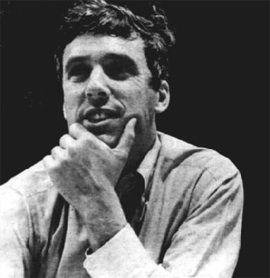
This isn’t Burt Bacharach’s birthday -– he’ll be 83 next May -– but this is as good a time as any to appreciate a master composer who is still with us.
This is just a personal take. Whenever I go back to Bacharach’s music, I can’t seem to stop. And so much of what I try to do in music is in the direction of what Bacharach started doing 50 years ago. Once I started playing those Bacharach-like major seventh chords, there was no looking back. But of course there's so much more to it. His songs are so fresh and modern and aerodynamic. Those harmonies, so simple yet sophisticated, as in bossa nova. It’s such a stylized, idiosyncratic sound, in two notes you can tell it’s Bacharach.
Listen to Dionne Warwick’s version of “I Say a Little Prayer.” Something fresh and exciting happens every two seconds. During the instrumental verse, the flugelhorn plays a line, then Dionne harmonizes with the horn, the time signature changes from 4/4 to 2/4, then the backup singers sing, “I say a little prayer for you,” the time signature changes back to 4/4, then Burt plays a fantastic piano riff. This all happens within six and a half measures.
Bacharach’s own mostly-instrumental albums give you the purest Bacharach. He plays piano, he conducts, he arranges, he produces. He takes the tunes way out, with crazy modulations and shifts in time signature, and he adds whole other themes that don’t appear in the vocal versions. Burt’s own version of “This Guy’s in Love With You” is my favorite – no disrespect to Herb Alpert.
Burt’s albums “Reach Out,” from 1967, and “Make It Easy on Yourself,” from 1969, constitute a one-two punch. Everything on those two records is so lively, from the compositions, of course, to the wild arrangements to the tight-as-a-drum performances to the sizzling rhythm section to the production. Those records are mixed in such a way that when you listen in stereo, you can point to the exact spot in your living room where the horns are, where the strings are, where the tambourine is. Special mention here to sound engineer Phil Ramone.
To see Bacharach in action in the studio, see this clip on YouTube of Cilla Black recording “Alfie” at Abbey Road in 1965, and see Bacharach conducting the orchestra, waving his arms like a sea lion. For my money, this is the best version of “Alfie,” by far.
Back in 1983 or so, I went to a free concert by Dionne Warwick in Boston Common. I didn’t care much about Dionne Warwick at the time -- I was a disaffected 23-year-old bass player in a loud rock band who had some very different ideas about music -- but I went as sort of a goof. The unannounced guest was Burt Bacharach, who played and conducted. And what a swinging bandleader he was that afternoon! As hard-headed as I was in those days, Bacharach got to me, without a trace of irony.
In 2000, I went to see Bacharach perform with a small orchestra at the Count Basie Theater in Long Branch, N.J. The man has so many hits that he literally could not play them all in a 90-minute concert, so he mashed them together into medleys, sung by four vocalists -– "Walk On By," "Do You Know the Way to San Jose," “The Look of Love," "You'll Never Get to Heaven," “Close to You,” "Promises, Promises," “A House Is Not a Home,” “Don’t Make Me Over,” “Wives and Lovers,” "A House Is Not a Home," “Trains and Boats and Planes,” “What’s New Pussycat,” “I’ll Never Fall in Love Again,” and on and on –- I haven’t told you the half of it -– ending with a big sing-along of “What the World Needs Now.” Let me tell you, as wild as I am about Burt Bacharach’s hits and his rarities, I never much cared for “Raindrops Keep Falling on My Head.” That tune always struck me as silly. But when he came out to do an encore, who was the idiot in the balcony who was singing along to "Raindrops" and swaying from side to side?
By the way, at that particular show, Bacharach had a young guy on second keyboard, playing organ and string parts. During a slow musical passage, this young guy started improvising, and some of his notes started going off the rails. Burt slowly turned around from the piano and cocked an eyebrow -- you wouldn't want to be on the other end of that -- and this young guy twisted his musical phrase upside-down to make it right, and in doing so, he twisted his body around until he was literally underneath his keyboard, looking up, with his elbow over his head. It all happened as if in slow motion. Talk about pressure.
In 2003, while I was recording some instrumental tunes for the “Side One” album, Mac Gollehon, an ace session musician, was going to play a flugelhorn part. I asked him if we could double-track the flugelhorn, to suggest that classic Burt Bacharach sound. Mac said, “I played with Burt Bacharach at a concert at Royal Albert Hall.” OK, then.
As I said, there's so much more. Bacharach's song "Hasbrouck Heights" is the best ode to a New Jersey town that this New Jersey native has ever heard. Heck, I even like the way he sings. And man, can that guy wear a tuxedo. And he's still at it.
Let’s appreciate Burt Bacharach while we still have him. Back in the 1970s I knew of Burt Bacharach, as many teenagers did at the time, from a TV commercial he and his then-wife Angie Dickinson did for Martini & Rossi vermouth. (See it here.) When Angie offers him a glass, Burt plays and sings:
"Say yes … yes
To Martini & Rossi on the rocks
Say yes."
Here’s to you, Burt.
